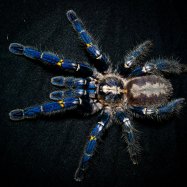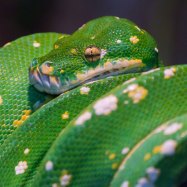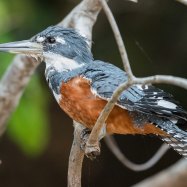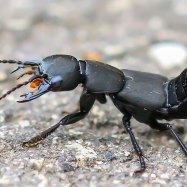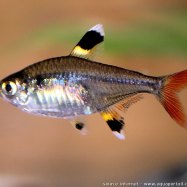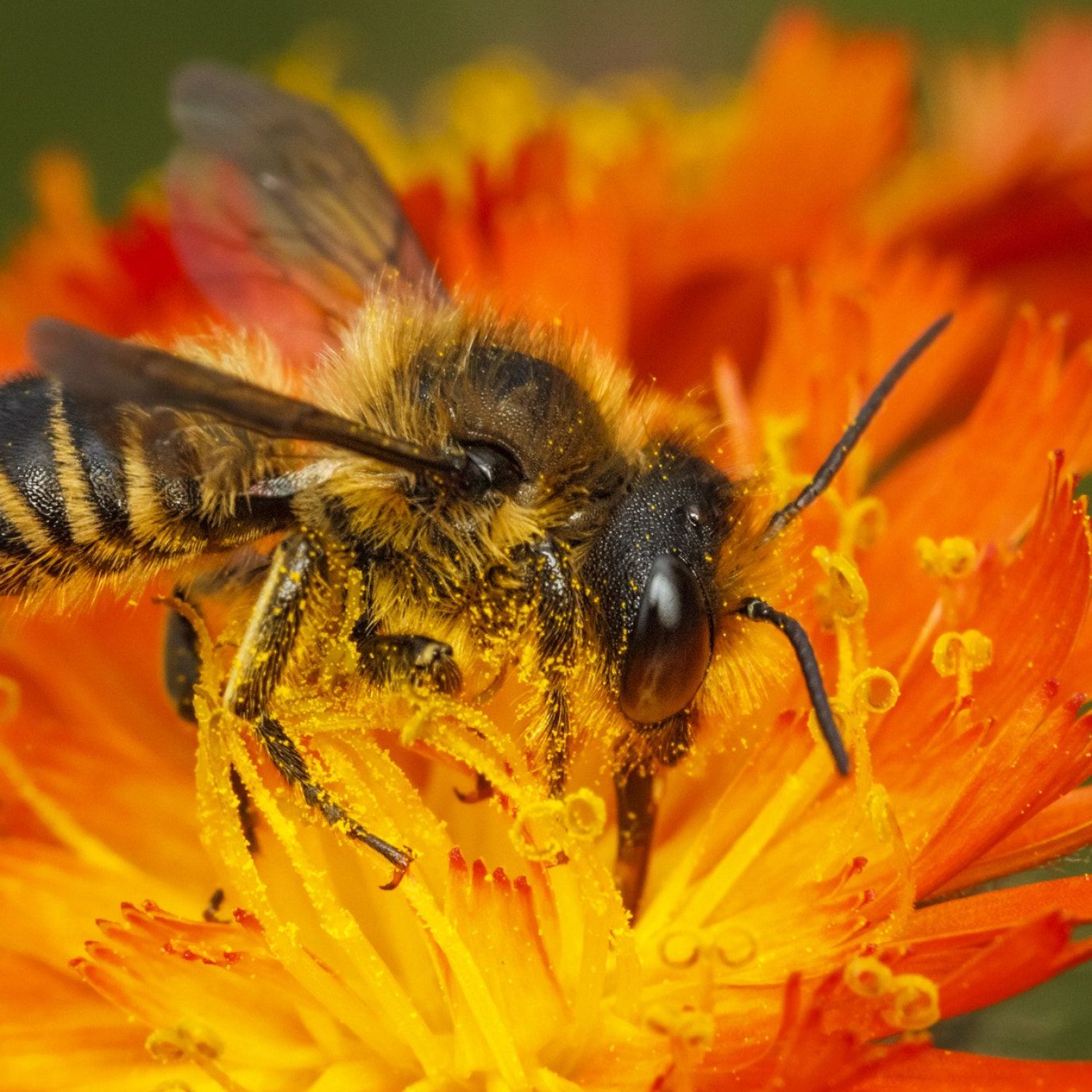
Leafcutter Bee
Leafcutter bees range in size from 8 to 18 mm (0.3 to 0.7 inches) in length.
Meet the Leafcutter Bee, a busy pollinator found in several countries worldwide. Ranging from 8 to 18 mm in length, these bees have a robust body and strong mandibles for cutting leaves. With its distinct head, thorax, and abdomen, the Leafcutter Bee is an essential member of the Megachilidae family. You can spot one in the United States, Canada, Mexico, Brazil, Australia, and China, so keep an eye out for these fascinating creatures in your garden!
Animal Details Summary:
Common Name: Leafcutter Bee
Kingdom: Animalia
Habitat: Leafcutter bees are found in a wide range of habitats including forests, woodlands, meadows, gardens, and urban areas.
Intriguing Facts About the Leafcutter Bee: A Master of Precision and Resourcefulness
The Leafcutter bee, also known by its scientific name Megachile, is a fascinating insect found in a variety of habitats all around the world. These bees are an essential part of the ecosystem, playing a vital role in pollination and aiding in the growth of many plant species. Although often overlooked, the Leafcutter bee possesses exceptional adaptations and behaviors that make it stand out among other insects. In this article, we'll delve deeper into the world of the Leafcutter bee and uncover its incredible features and capabilities Leafcutter Bee.Description and Habitat
The Leafcutter bee belongs to the kingdom Animalia, phylum Arthropoda, and class Insecta. It falls under the order Hymenoptera, which includes other bee species, wasps, and ants. The Leafcutter bee is a member of the family Megachilidae, which consists of over 1,300 species of bees. This family is characterized by their robust bodies and strong mandibles, used for cutting leaves.These fascinating bees are found in a wide range of habitats, including forests, woodlands, meadows, gardens, and even urban areas. They are also known to thrive in agricultural landscapes, making them a crucial contributor to crop pollination. Leafcutter bees are widely distributed in North America, South America, Europe, Africa, and Asia, but they are native to Europe.
Feeding Behavior
Leafcutter bees are herbivorous insects that primarily feed on nectar and pollen from flowers. They play a significant role in pollination, collecting pollen on the hair of their abdomen as they move from flower to flower Lurcher. In doing so, they help in the reproduction of many plant species and contribute to the growth of agricultural crops. These bees are also crucial in maintaining the genetic diversity of plant species, as they are known to pollinate a wide range of plants.Leafcutter Bees: Master of Precision
One of the most distinctive features of Leafcutter bees is their method of collecting plant material. As their name suggests, these bees use their strong mandibles to cut circular or oval-shaped pieces of leaves, which they then use to build their nests. They are incredibly precise in their cutting, so much so that their pieces of leaves almost resemble perfect circles. This precision is essential for creating a sturdy nest, as well as for the protection of their offspring.Nest-Making Behavior
Leafcutter bees are solitary insects, meaning they do not live in colonies like other bee species. They create individual nests using pieces of leaves, mud, and their saliva. The Leafcutter bee is meticulous in its nest-making process, exhibiting exceptional resourcefulness and intelligence. First, the female bee finds a suitable vertical surface, such as the side of a tree or a wall, to build her nest. Then, using her strong mandibles, she cuts perfect circles of leaves, which she then carries one by one to her chosen location.Once enough leaf pieces have been gathered, the female bee carefully arranges them in layers, securing them together with mud and her saliva. She also creates small chambers within the nest, where she deposits pollen and nectar for her offspring. Once the nest is complete, the female bee lays a single egg in each chamber, before sealing it shut with a final layer of mud. This process requires incredible precision, as any gaps or weak spots in the nest could be detrimental to the survival of the offspring.
Social Behavior
While Leafcutter bees are solitary insects, they do exhibit some degree of social behavior. Multiple females can often be found making nests in the same area, although they each have their own individual nests. Interestingly, these bees also engage in a behavior called "social nest building." This occurs when multiple females work together to construct a nest, using different types of leaf materials. By collaborating, the bees can create more robust and intricate nests, leading to higher success rates for their offspring.Incredible Adaptations
Apart from their exceptional nest-making abilities, Leafcutter bees have some remarkable adaptations and behaviors that make them stand out among other bee species. One of their most impressive adaptations is their ability to adjust their size according to the size of the nest chamber. This incredible feat is achieved by controlling the amount of food they consume during their larval stage. The more food they consume, the larger their body size, making them the perfect fit for their nest.Another fascinating adaptation of the Leafcutter bee is their ability to navigate through the most intricate of pathways. When carrying large pieces of leaves, these bees sometimes have to fly through narrow tunnels and obstacles to reach their nest. To accomplish this, Leafcutter bees have developed excellent spatial memory, which helps them navigate through these challenging pathways.
Fascinating Colors and Body Shape
The coloration of Leafcutter bees varies depending on the species, but most are black or brown with bands of lighter colors on their abdomen. Their robust body shape is also another characteristic feature, with distinct head, thorax, and abdomen. They have long, strong antennae used for sensing their environment and locating water and food sources.In Conclusion
The Leafcutter bee may seem like a small and insignificant insect to some, but its adaptations and behaviors make it an essential part of the ecosystem. From their precise leaf-cutting to their resourcefulness in nest-making, these bees truly are masters of precision and resourcefulness. The Leafcutter bee serves as a perfect example of how insects can exhibit remarkable intelligence and contribute to the growth and sustainability of our planet. So the next time you see one of these little bees buzzing around, take a moment to appreciate the incredible creatures they are.

Leafcutter Bee
Animal Details Leafcutter Bee - Scientific Name: Megachile
- Category: Animals L
- Scientific Name: Megachile
- Common Name: Leafcutter Bee
- Kingdom: Animalia
- Phylum: Arthropoda
- Class: Insecta
- Order: Hymenoptera
- Family: Megachilidae
- Habitat: Leafcutter bees are found in a wide range of habitats including forests, woodlands, meadows, gardens, and urban areas.
- Feeding Method: Leafcutter bees are herbivorous insects that primarily feed on nectar and pollen from flowers.
- Geographical Distribution: Leafcutter bees are found throughout North America, South America, Europe, Africa, and Asia.
- Country of Origin: Leafcutter bees are native to Europe.
- Location: Leafcutter bees can be found in various countries around the world, including the United States, Canada, Mexico, Brazil, Australia, and China.
- Animal Coloration: The coloration of leafcutter bees varies depending on the species, but most are black or brown with bands of lighter colors on their abdomen.
- Body Shape: Leafcutter bees have a robust body with a distinct head, thorax, and abdomen. They have strong mandibles for cutting leaves.
- Length: Leafcutter bees range in size from 8 to 18 mm (0.3 to 0.7 inches) in length.
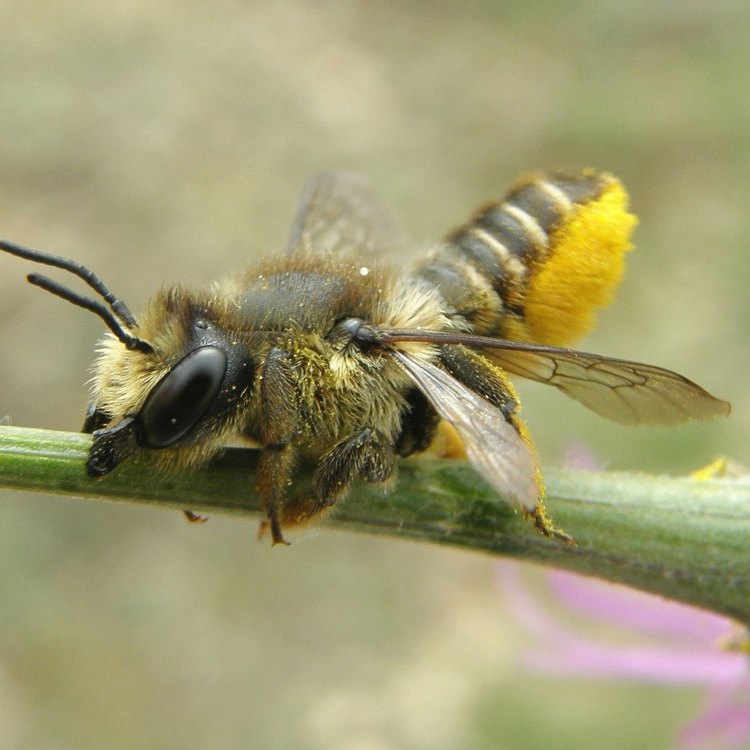
Leafcutter Bee
- Adult Size: The adult size of leafcutter bees varies depending on the species, but most are around 12-16 mm (0.5-0.6 inches) long.
- Average Lifespan: Leafcutter bees have a relatively short lifespan, typically living for about 1 year.
- Reproduction: Leafcutter bees are solitary insects, meaning they do not live in colonies like honey bees. Female leafcutter bees construct individual nests in tunnels or cavities and lay their eggs inside. They also provide provisions of pollen and nectar for the developing larvae.
- Reproductive Behavior: Male leafcutter bees often gather near nest sites and compete for mating opportunities with the females. After mating, the female will construct a nest and lay her eggs.
- Sound or Call: Leafcutter bees do not produce any distinctive sound or call.
- Migration Pattern: Leafcutter bees are not known for long-distance migrations. They typically stay within their local habitat.
- Social Groups: Leafcutter bees are solitary insects and do not form colonies or social groups.
- Behavior: Leafcutter bees are primarily active during the day and are efficient pollinators of various flowering plants. They are known for their unique leaf-cutting behavior, where the females cut circular or oval-shaped pieces of leaves to construct their nests.
- Threats: Leafcutter bees face threats from habitat loss, pesticide use, climate change, and competition with introduced bee species.
- Conservation Status: Leafcutter bees are not currently listed as a globally threatened species, but some local populations may be at risk.
- Impact on Ecosystem: Leafcutter bees play a crucial role in plant pollination, contributing to the overall health and diversity of ecosystems.
- Human Use: Leafcutter bees are often used as managed pollinators in agricultural settings, particularly for crops like alfalfa, onions, and sunflowers.
- Distinctive Features: One of the distinctive features of leafcutter bees is their leaf-cutting behavior, where they use their mandibles to cut circular or oval-shaped pieces of leaves to construct their nests.
- Interesting Facts: 1. Leafcutter bees are excellent pollinators and are more efficient pollinators than honey bees for certain crops. 2. Leafcutter bee nests can be found in various places, including hollow plant stems, abandoned beetle burrows, and even man-made structures like bee hotels. 3. Leafcutter bees are important for the production of alfalfa, which is commonly used as livestock feed. 4. Leafcutter bees are solitary bees and are generally not aggressive towards humans.
- Predator: Leafcutter bees may be preyed upon by birds, spiders, and other small predators.
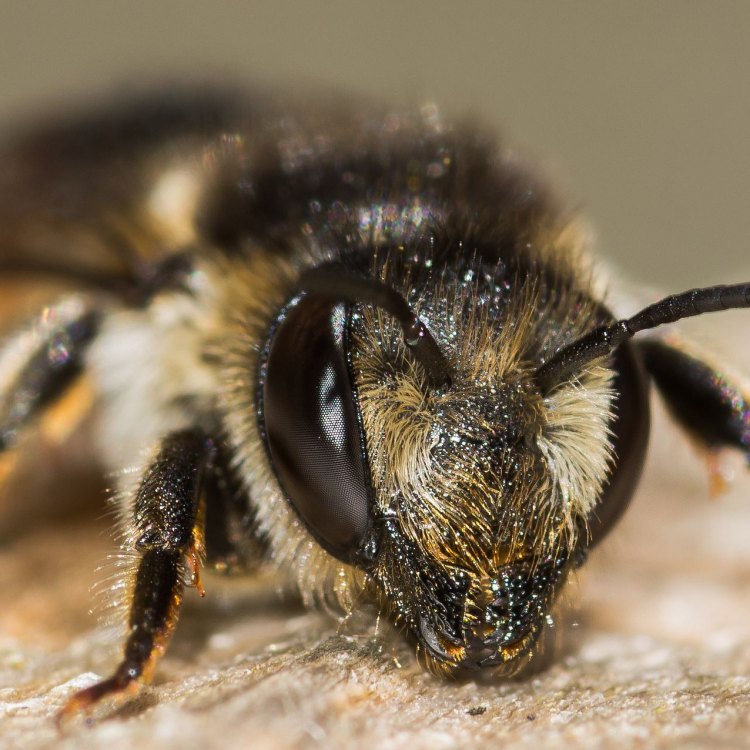
Megachile
The Fascinating World of Leafcutter Bees: An Integral Part of Ecosystems
In the bustling world of bees, the honey bee often takes center stage. However, there is another group of bees that are just as important, yet often overlooked - leafcutter bees. These solitary insects may not produce honey, but they play a vital role in pollination and contribute to the overall health and diversity of ecosystems. In this article, we will dive into the fascinating world of leafcutter bees, from their behavior and distinct features to their impact on the environment and human use PeaceOfAnimals.Com.Adult Size and Average Lifespan
Leafcutter bees belong to the genus Megachile, which consists of over 1,400 species worldwide. Their sizes may vary depending on the species, but on average, they are around 12-16 mm (0.5-0.6 inches) long. This makes them slightly smaller than honey bees, which typically measure around 17-20 mm in length. Leafcutter bees have a relatively short lifespan, typically living for about a year.
Reproduction and Reproductive Behavior
Unlike honey bees, which live in large colonies with a single queen, leafcutter bees are solitary insects. This means that they do not live in colonies and do not have a queen. Instead, female leafcutter bees construct individual nests in tunnels or cavities, typically in dead twigs or wood Lionfish. They use their strong mandibles to cut circular or oval-shaped pieces of leaves, which they use to line their nests.
The female leafcutter bee also lays her eggs inside the nest and provides provisions of pollen and nectar for the developing larvae. She carefully packs each cell in the nest with a mixture of pollen and nectar, and then lays a single egg on top. This mixture not only provides food for the growing larvae but also serves as a waterproof barrier between the larva and the leaf-cutting.
Reproductive behavior among leafcutter bees is also quite fascinating. Male leafcutter bees often gather near nest sites and compete for mating opportunities with the females. After mating, the female will construct a new nest and lay her eggs, while the male will continue to search for more mating opportunities.
Sound or Call and Migration Pattern
If you're hoping to hear the distinctive buzz of a leafcutter bee, you may be disappointed. Unlike some bee species, leafcutter bees do not produce any particular sound or call. Additionally, they are not known for long-distance migrations. They typically stay within their local habitat, where they have access to a variety of flowering plants for food and suitable nesting sites.
Social Groups and Behavior
As mentioned earlier, leafcutter bees are solitary insects. They do not live in colonies or form social groups like honey bees. Instead, they are primarily active during the day, foraging for pollen and nectar from various flowering plants. Their behavior is essential in the pollination of these plants, making them efficient pollinators.
One of the most distinctive features of leafcutter bees is their leaf-cutting behavior. As mentioned earlier, female leafcutter bees use their mandibles to cut circular or oval-shaped pieces of leaves, which they then use to construct their nests. This behavior may seem destructive to plants, but it actually benefits them. The leaf-cutting process stimulates new growth in the plant, resulting in a more abundant supply of flowers and fruits.
Threats and Conservation Status
Unfortunately, leafcutter bees, like many other bee species, face several threats. Habitat loss due to urbanization and agricultural practices, pesticide use, climate change, and competition with introduced species, are some of the main factors contributing to their decline in certain areas.
Although leafcutter bees are not currently listed as globally threatened, some local populations may be at risk. It is essential to protect their habitats and reduce the use of harmful pesticides to ensure the survival of these vital pollinators.
Impact on Ecosystems and Human Use
Leafcutter bees play a crucial role in plant pollination, contributing to the overall health and diversity of ecosystems. They are efficient pollinators of various flowering plants, including crops like alfalfa, onions, and sunflowers. Their unique leaf-cutting behavior also benefits these plants, resulting in more significant yields and higher-quality crops.
In addition to their impact on ecosystems, leafcutter bees also have a vital role in human use. They are often used as managed pollinators in agricultural settings, particularly for crops like alfalfa, which is commonly used as livestock feed. Without leafcutter bees, the production of these crops could be severely affected, resulting in potential economic losses.
Distinctive Features and Interesting Facts
Apart from their leaf-cutting behavior, there are some other distinctive features and interesting facts about leafcutter bees that are worth mentioning. For instance, they are excellent pollinators and are more efficient pollinators than honey bees for certain crops. Additionally, their nests can be found in various places, including hollow plant stems, abandoned beetle burrows, and even man-made structures like bee hotels.
Alfalfa, which is an essential crop for livestock feed, relies heavily on leafcutter bees for pollination. Therefore, the decline of leafcutter bee populations could have severe consequences for the production of this crop.
Another interesting fact is that leafcutter bees are solitary bees and are generally not aggressive towards humans. Unlike honey bees, which can sting multiple times, leafcutter bees can only sting once, and their stings are not as painful. However, it is still essential to give these bees their space and avoid disturbing their nests.
Predators
As with any other species, leafcutter bees also have predators. Some of their main predators include birds, spiders, and other small predators. However, it is worth noting that leafcutter bees are not a significant food source for these predators, and their populations are more affected by human activities and habitat loss.
In conclusion, leafcutter bees may not be as famous as honey bees, but they are just as essential. Their unique leaf-cutting behavior, role in pollination, and impact on ecosystems make them a vital part of our planet's biodiversity. As we continue to learn more about these fascinating creatures, it is crucial to protect their habitats and ensure their survival for the benefit of both humans and the environment.
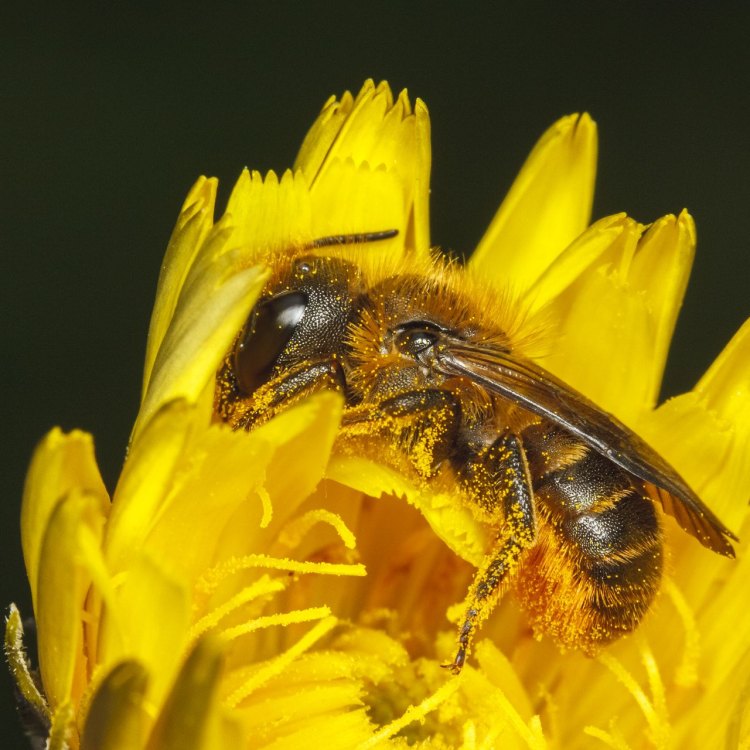
Intriguing Facts About the Leafcutter Bee: A Master of Precision and Resourcefulness
Disclaimer: The content provided is for informational purposes only. We cannot guarantee the accuracy of the information on this page 100%. All information provided here may change without prior notice.




